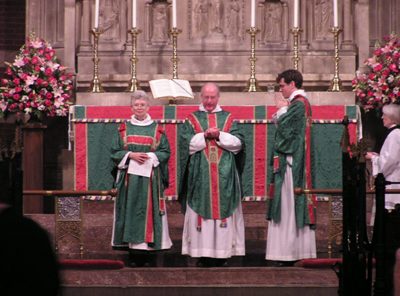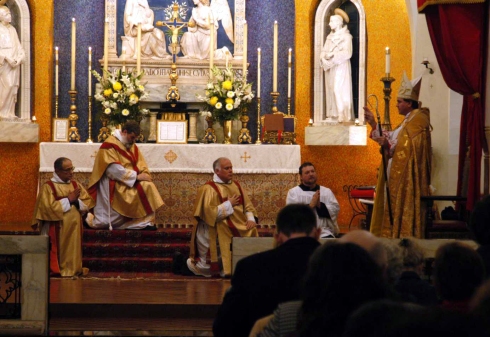If you aren’t sure what Anglo-Catholics are all about, you’re about to discover who they are. This isn’t intended for Anglicans as much as it is for Roman Catholics and other Christians who wonder what this world is all about.
Today’s post is a bit of a pictorial by way of a gentle introduction. I hope the churches profiled below will not mind my having borrowed their photographs, which are too good to miss.
Church of the Advent, Boston, MA:

Note not only the vestments but the traditional altar. I went to a few Masses here many years ago. If you’re in Boston or live nearby, it’s definitely worth a visit.
From the website (link above):
Worship at the Church of the Advent reflects our foundation in the tradition of the ‘Oxford Movement’. Beginning in the 1830s, several Church of England clergy, in reaction to what they perceived as the laxity and spiritual lifelessness the Church in their day, started a renewal which came to be known as the Oxford Movement (because most of them were associated with Oxford University). They advocated a restoration of the pattern of Catholic worship, devotion, and spirituality which originated in ancient times but was lost during the Reformation. The recoveries included an ornate liturgy, private confession, devotions addressed to the Blessed Virgin Mary, and monastic orders, as well as the use of the name ‘Mass’ for the service of the Eucharist …
In addition to ceremonial recoveries, scholars of the Oxford Movement also led a rediscovery of classical Catholic theology, which included an elevated view of the Sacrament of the Eucharist, in which we believe Christ to be really present to us in the sacramental bread and wine – His Body and Blood. From a Catholic viewpoint, worshipping Christ present in the Sacrament of the Eucharist is an experience so profound that words become inadequate and ceremonial gestures, such as the Sign of the Cross and genuflections, serve to express some of what we cannot put into speech.
St Michael and All Saints Church, Edinburgh:

From the website (link above):
As adherents to the Anglo-Catholic tradition, incense, bells and music play an integral part in our worship and the ritual and beauty of the liturgy is an important aid to our worship …
On the first Sunday of each month we also have a service of Choral Evensong and Benediction at 6.30 pm. Evensong is a traditional service, with readings and prayers, psalm, Magnificat, Nunc Dimittis and anthem sung by the choir. It is followed seamlessly by the service of Benediction of the Blessed Sacrament, when we rejoice in the Lord’s continuing presentation of himself to the world …
St Mary of the Angels, Los Angeles, CA:

From the website (link above):
From her earliest days, St. Mary’s has enjoyed the full Anglo-Catholic heritage of worship and belief. Employing the Book of Common Prayer for the daily and occasional offices and the Anglican Missal for the celebration of the Mass, Fr. Neal Dodd, our first rector, set the tone for our worship which remains today.
To some, that heritage means ‘smells and bells’ — incense, beautiful vestments, and intricate ceremonial. At High Mass or Solemn Evensong, we do cloud the church with incense, the vestments of the clergy and, in fact, all things connected with our worship, are as beautiful as our skills and pocketbooks allow. The ceremonial that embodies our worship and the music which accompanies it, are rich and old. It has the scent of eternity. That’s what we believe worship should be.
Worship isn’t about us. It’s not meant to make us feel good about ourselves, or even to feel good about God. Its purpose isn’t to make us ‘feel’ anything. Worship is directed not toward us, but towards God. Catholic worship is what the Church of God does to show her love for her Lord.
Other points to note, as taken from a short and highly readable essay by Bruce E Ford entitled ‘What is an Anglo-Catholic parish?‘ for the Grace Church in Newark, NJ, website:
That the Church of England was not denomination, founded at the Reformation, but the selfsame branch of the Catholic Church planted by missionaries from Rome and Ireland in the sixth century.
That Christ’s promise to lead his disciples into all truth was addressed to the whole Church, not to any single branch of it, and that the only authoritative teaching was that which had been accepted throughout the Church before the break between East and West in 1054.
That although the Church of England, reacting to increasingly extravagant claims about papal authority for which Catholic tradition provided little support, had declared its independence from Rome in the sixteenth century, it had not cut itself off from communion with the Church of Rome, but that schism had occurred only in 1570 when Pope Pius V had excommunicated Queen Elizabeth I.
That the Book of Common Prayer ought not necessarily to be interpreted as its compilers intended, but according to the tradition of the Catholic Church.
The essay goes on to explain:
Because Anglo-Catholics view the Church as an extension of the incarnation, they have historically felt impelled to attend in Jesus’ Name to ‘the homeless, the hungry, the desolate, and the oppressed’. In America, where in the nineteenth century Episcopal churches derived most of their income from rental of pews, Anglo-Catholic parishes were among the first to abandon it, opening the way for all to join in their worship.
A long-standing Anglo-Catholic friend confirms this. So, despite the impressive, traditional vestments, the Anglo-Catholics have been and continue to be the ones doing much of the hard graft in urban Anglican missions.
And:
Anglo-Catholics recognize that authoritative Catholic teaching about many matters does not exist. They confidently affirm that Christ is present in the Blessed Sacrament, but they regard all attempts to say how he is present as mere speculation. They confidently affirm the virginal conception of Jesus; but while some believe that the Virgin Mary was immaculately conceived and that she was bodily assumed into heaven, others do not. Popes in recent times have proclaimed both the doctrine of the Immaculate Conception and the doctrine of the Bodily Assumption of Mary to be dogma, even though theologians have debated the about both doctrines for centuries without reaching consensus. Anglo-Catholics regard papal proclamations on unsettled questions not as Catholic teaching but as examples of blatant Roman sectarianism.
Many Anglo-Catholics would nod their heads upon reading that statement.
Tomorrow: The many facets of Anglo-Catholicism





7 comments
November 17, 2009 at 8:38 am
Antonella
Interesting Churchmouse……..I thought the break occurred with Henry VIII who wanted to divorce his wife Catherine of Aragon to marry Anne Boleyn and the Roman catholic church would not allow it, hence, his break away….as he was King he decreed it and any opposition was dealt with (beheading)! Thomas Moore etc……
LikeLike
November 17, 2009 at 8:53 am
churchmouse
It was the trigger but not the full break. The beliefs and doctrine were still in communion with Rome, although Henry’s personal behaviour (divorce) was not. They didn’t go off straightaway to devise the 39 Articles, which came later.
It makes for a more exciting story to say it all happened with Henry VIII. The excommunication of Good Queen Bess is a bit less dramatic in the line of Christian ‘mythology’, for lack of a better word. But, it was at that point when the C of E then looked to the Reformers, Luther and Calvin.
LikeLike
November 17, 2009 at 3:51 pm
Gabriella
In the years before the Motu Proprio I often attended Mass in beautiful Anglican churches 🙂 (to avoid the ugliness of the modern assemblies). Like you, I’m a church hopper.
In many respects, there are no differences between the two churches. They are both Christian churches, springing from the same ancient source as the Eastern Orthodox churches except for the peculiarly Anglican view of authority, which flows from the edges to the center 😉
The Archbishop of Canterbury has no legal authority outside of the Diocese of Canterbury. He serves as spiritual leader and symbol of unity.
The laity have real power at all levels of the Anglican churches (though with local variations). Anglicans look to their diocesan and national synods of bishops, clergy and laity to interpret matters of faith and order. Unlike the Church of Rome, with its admirable clarity of decision-making, the Anglican churches are messy and often disagree with each other. For instance, some churches ordain women to all three orders of ministry. Many do not at all, and the Church of England ordains women to the diaconate and the priesthood, and to the episcopate (I’m not sure about this last one).
Having rejected the authority of Peter’s successor, the Pope, the Reformers substituted the private judgment of the faithful. Individual judgment takes the place of all Church authority. Every man, they said, who hears or reads the Scriptures, is enlightened and inspired by the Holy Ghost to such a degree that the Scriptures become clear to him and the soul is filled with inspiration. Hence, Universality and Unity of Faith must of necessity follow as the Holy Ghost, the Spirit of Truth, is one and cannot contradict Himself.
This principle of individual inspiration, instead of being a bond of union, has proved to be a terrible cleaver. Every protestant can be a church in himself and unto himself.
I’m hoping and praying that the more orthodox Anglican communities join the more orthodox Catholic groups in great numbers now that the Pope has opened the doors wide. It is the orthodox that keep our faith and our liturgies and traditions pure and incorrupted throughout the centuries. It is the orthodox, if united, that are the future of our churches 🙂
Thanks Churchmouse for letting me have my say 😉
LikeLike
November 17, 2009 at 3:58 pm
churchmouse
I was on standby … 😉
Have a good evening! 🙂
LikeLike
February 1, 2010 at 8:01 pm
Nicholas
The Mass isn’t something that we do for God. It’s something that God does for us. In corporate worship, “I” becomes “we”, and we submit ourselves to the demands of ritual and tradition. These link us, not only to God and His saints, but to like minded Christians all over the world, and to those ancestors who bequeathed our spiritual heritage to us. I am grateful that Anglicans rediscovered this long ago, and believe that those coming “to Rome” will do much to restore beauty, awe, mystery and integrity to Catholic liturgy and devotions. Before the Reformation, England (which cherished its Roman Catholic faith) was called “Mary’s Dowery”, and not without reason.
LikeLike
February 1, 2010 at 9:51 pm
churchmouse
What a beautiful comment, Nicholas! Thank you so much — and welcome to the blog!
LikeLiked by 1 person
April 12, 2010 at 7:07 am
heading to Rome
http://www.Atonementonline.com (Anglican Use in full union with Rome)
http://www.ScriptureCatholic.com
http://www.Anglicanuse.com
http://www.Walsingham-church.org
http://www.Anglicanuseconference.com
“St Peter lives in Rome” by Dr. Robert A. Stackpole[former Anglican priest]
Douay Rheims Bible
Catechism of the Catholic Church
LikeLike